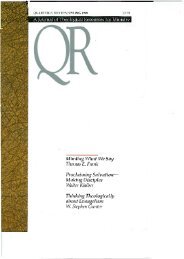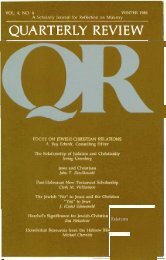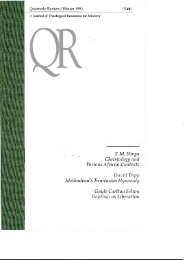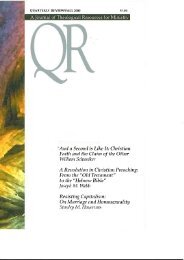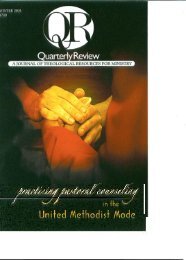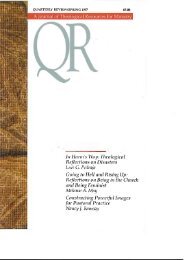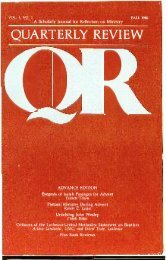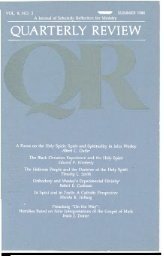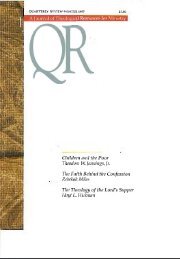TJieodore W. Jennings, Jr. The Meaning of ... - Quarterly Review
TJieodore W. Jennings, Jr. The Meaning of ... - Quarterly Review
TJieodore W. Jennings, Jr. The Meaning of ... - Quarterly Review
You also want an ePaper? Increase the reach of your titles
YUMPU automatically turns print PDFs into web optimized ePapers that Google loves.
to save them from "the wrath to come." Times were very difficult<br />
and infants <strong>of</strong>ten died. <strong>The</strong> fear <strong>of</strong> damnation answered by doctrinal<br />
theories <strong>of</strong> atonement justified the universal baptism <strong>of</strong> infants. <strong>The</strong><br />
Reformers would later complain that the work <strong>of</strong> Christ took on an<br />
almost magical quality in medieval Christianity as parents hastened<br />
to insure the salvation <strong>of</strong> their children. <strong>The</strong> modern church must be<br />
sensitive to the parental and pastoral concerns that called forth<br />
instant infant baptism.<br />
By the end <strong>of</strong> the sixth century, baptism and confirmation had<br />
become two separate sacraments. 27<br />
<strong>The</strong> church also made a<br />
complete shift from the traditional unified rite for adult believers to<br />
the baptism and separate confirmation <strong>of</strong> infants. To be sure, the<br />
ritual was somewhat slower to change. <strong>The</strong> ceremony that had once<br />
been designed for adult converts took on an air <strong>of</strong> unreality when<br />
said for infants. However,<br />
even when adult baptism ceased to be the rule, and infant baptism became<br />
standard, the water-bath was followed by eucharist, with the infant<br />
receiving a drop <strong>of</strong> the consecrated wine. This is still part <strong>of</strong> the<br />
eastern Church's rituals, and it lasted in the West until the cup was<br />
taken from the laity in the early Middle Ages. When the consecrated<br />
bread became the only form for eucharistic reception open to the laity,<br />
the eucharistic aspect <strong>of</strong> the baptismal liturgy in the West was<br />
dropped. 28<br />
Loss <strong>of</strong> Sacred Memory<br />
As the time between the sacraments <strong>of</strong> baptism and confirmation<br />
lengthened, many Christians forgot the traditional purpose <strong>of</strong><br />
chrismation/confirmation. Eusebius Gallicanus, writing in the fifth<br />
century, exclaimed:<br />
What good can it do to me, after the mystery <strong>of</strong> baptism, to have<br />
the ministration <strong>of</strong> confirmation? So far as I can see, we have not<br />
obtained everything from the font, if after the font we still need<br />
29<br />
something new.<br />
Both Martin Luther and John Wesley inherited this fifth-century<br />
confusion. Luther and other mainline continental reformers attacked<br />
the Roman Catholic sacrament <strong>of</strong> confirmation and regarded the rite<br />
30 QUARTERLY REVIEW/SPRING 1993



